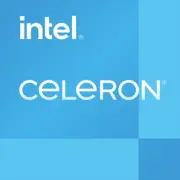Intel Celeron G1830

Intel Celeron G1830: Architecture, Compatibility, and Use Cases in 2025
(An Overview for Enthusiasts and Owners of Legacy Systems)
1. Key Features: Moderate Power for Basic Tasks
Architecture and Process Technology
The Intel Celeron G1830, released in 2014, is based on the Haswell microarchitecture (4th generation Core) and is manufactured using a 22-nm process. This dual-core CPU does not support Hyper-Threading (2 cores / 2 threads), with a base frequency of 2.8 GHz. It features a 3 MB L3 cache and has a TDP of 54 W. Integrated Intel HD graphics (Haswell) provide basic performance for office tasks and HD video.
Key Features:
- Low power consumption (suitable for compact PCs).
- Support for SSE4.2 and AVX 2.0 instructions.
- No Turbo Boost and no unlocked multiplier.
Performance:
In the Geekbench 6 test (2025), the processor achieves:
- 535 points (Single-Core);
- 940 points (Multi-Core).
These results are comparable to modern budget ARM chips (e.g., Qualcomm Snapdragon 7c Gen 3), but for x86 tasks, the CPU performs poorly: even Intel Celeron G6900 (2022) outperforms it by 2–3 times.
2. Compatible Motherboards: Searching the Archives
Socket and Chipsets
The processor uses the LGA 1150 socket, compatible with Intel 8-series chipsets:
- H81, B85, H87, Z87.
Selection Recommendations:
- H81 — Optimal for budget builds (price of new boards in 2025 — starting at $70, but they are scarce).
- Z87 — For enthusiasts (supports RAM overclocking, but the G1830 itself is not overclockable).
Examples of Boards:
- ASRock H81M-DGS R2.0 — Mini motherboard with basic features.
- Gigabyte GA-B85M-D3H — 4 DDR3 slots, SATA 6 Gbps.
Important: New LGA 1150 boards in 2025 are rare.
3. Supported Memory: Only DDR3
Celeron G1830 works exclusively with DDR3 (not compatible with DDR4/DDR5).
- Frequencies: 1333 MHz / 1600 MHz (depending on the chipset).
- Max capacity: 32 GB (theoretically), but in practice, H81/B85 boards rarely support more than 16 GB.
Tip: Use a dual-channel configuration (2×4 GB or 2×8 GB) to increase bandwidth.
4. Power Supplies: Minimum Watts
With a TDP of 54 W, the processor does not require a powerful PSU.
- Recommendations:
- For a system without a discrete graphics card: PSU rated at 300–400 W (e.g., EVGA 400 N1, $35).
- With a GTX 1650-level graphics card: 450–500 W (Corsair CX450, $55).
Important: The integrated HD graphics (Haswell) consume up to 10 W, so for a PC without a GPU, even low-powered units will suffice.
5. Pros and Cons: For a Very Limited Range of Tasks
Pros:
- Low price (new CPUs in 2025 — around $40, if found).
- Energy efficiency.
- Support for legacy OS (Windows 7, Linux with 3.x kernel).
Cons:
- Poor performance in multi-threaded tasks.
- No NVMe, USB 3.1, DDR4 support.
- Outdated platform (risk of lacking drivers for new OS).
6. Use Scenarios: Where is the G1830 Still Relevant?
Office and Web Browsing
- Document work, browser (up to 10 tabs), Zoom calls.
- Limitation: Slow performance when streaming 4K video or with heavy web applications (Google Meet with background effects).
Multimedia
- Playback of 1080p video through VLC or Kodi.
- Issues: 4K HDR is not supported by integrated graphics.
Light Gaming
- Older titles: Half-Life 2, Minecraft (on low settings).
- Test: GTA V — 15–20 FPS on minimum settings (when paired with a GT 1030).
7. Comparison with Competitors: Against Modern Budget Options
Intel Celeron G6900 (Alder Lake, 2022)
- 2 cores / 2 threads, 4 MB L3, UHD 710.
- Geekbench 6: 1250 (Single), 2100 (Multi).
- Price: $55. Summary: 2 times faster, DDR4 support.
AMD Athlon 3000G (Zen, 2019)
- 2 cores / 4 threads, Vega 3.
- Geekbench 6: 850 (Single), 1650 (Multi).
- Price: $60. Summary: Better in multi-threading but weaker in single-core.
Conclusion: The G1830 struggles against budget processors from 2019–2022.
8. Practical Assembly Tips
- SSD is a must: Replace HDD with a SATA SSD (Kingston A400, $25/240 GB) for system speedup.
- Don’t overpay for the motherboard: Look for H81/B85 with warranties.
- Upgrade: Consider a Core i5-4570 level CPU (4 cores / 4 threads, $20–30 used).
- Cooling: The standard stock cooler is sufficient.
9. Final Conclusion: Who is This Processor For?
The Celeron G1830 in 2025 is suitable for:
1. Owners of old PCs looking to upgrade (e.g., from Pentium G3220).
2. Enthusiasts building retro systems on Windows XP/7.
3. For terminals in offices or educational institutions (printing, databases).
Why not consider it for new builds?
Even with a budget of $200–300, you will find more modern options (Intel N100, AMD Ryzen 3 5300U) that offer better performance, DDR4 support, and NVMe.
Final Thought: The G1830 is a relic of the past, still relevant only in narrow niches. Its time has passed, but it may still serve nostalgic projects.
Basic
CPU Specifications
Memory Specifications
GPU Specifications
Benchmarks
Compared to Other CPU
Share in social media
Or Link To Us
<a href="https://cputronic.com/index.php/cpu/intel-celeron-g1830" target="_blank">Intel Celeron G1830</a>